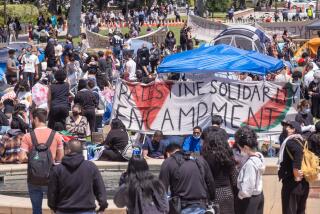Protesters Try to Keep Faith
- Share via
PINELLAS PARK, Fla. — In low, gray skies, a small plane circled Thursday, tugging a banner imploring Florida’s governor: “Rescue Terri Now.”
Outside the grounds of Woodside Hospice, where Terri Schiavo was in her seventh day without food or water following last Friday’s court-ordered removal of a feeding tube, demonstrators -- some of whom had been there for days -- camped out on quilts and blankets, looked upward, cheered and waved signs of their own:
“Free Terri.” “Pray.” “Hospice or Auschwitz.”
When a television correspondent launched into a live broadcast outside the hospice in this suburb north of St. Petersburg, the crowd at her back took up a chant: “Save Terri now.” In early evening, when the TV lights went on again, the chant turned into “Give Terri water.”
With institutional avenues for keeping the 41-year-old brain-damaged woman alive shutting one by one, even some of the most fervent advocates of preventing her death appeared resigned to it.
“You need to prepare your hearts,” the Rev. Pat Mahoney, leader of the Christian Defense Coalition, told demonstrators in the morning. “Dear God, whatever it is you are doing with our sister, we trust it is for the good.”
Msgr. Thaddeus F. Malanowski, a retired Roman Catholic priest who serves as Terri Schiavo’s chaplain, said that “only a little miracle, or a big miracle, is going to help us save Terri.”
Malanowski led some of the hospice protesters in prayer and hymns in a “holy hour” to commemorate Maundy Thursday, a holy day before Easter.
In one respect, Malanowski said, Schiavo is like Jesus, whose death and resurrection are commemorated today and on Easter.
“Terri, like he, is dying unjustly,” the monsignor said.
The number of demonstrators outside the hospice has ranged from a few dozen on some days to Thursday’s crowd of about 150.
A circle of supporters in camp chairs vowed to read the entire Bible aloud -- by midafternoon Thursday they had gotten to Chapter 4 of Exodus. One middle-aged woman stood by the hospice’s semicircular driveway and repeatedly recited the Apostles’ Creed.
A choir of young people sang “Jesus Loves Me.”
Demonstrator Becki Snow, 42, of Dallas was in her seventh day without food. She has allowed herself sips of water from time to time.
“I wanted to prove it’s not painless to die of hunger or thirst,” she said, adding that the “first 24 hours were pure hell.” On Thursday she experienced nausea and painful cramps, she said.
Mary Fernandez, an English teacher from Tampa, had been collecting donations to send roses to President Bush and his brother Jeb, Florida’s governor, in a bid to “melt their hearts” on Schiavo’s behalf.
She said the money she had amassed in a cocoa box would be used instead to help pay bail for protesters who had been arrested in the last week on trespassing charges as they symbolically tried to carry water to Schiavo inside the hospice.
“This is a hostile takeover of our country by the judiciary,” Fernandez said, referring to a series of state and federal court actions in the case. “I’m just so mad.”
The Garr family of Louisville, Ky., drove 900 miles from their home to Pinellas Park. Parked in front of a supermarket, their car also became their hotel room.
They were “led here by the Lord,” said George Garr, 50, a painting contractor.
“We pray for a miracle,” said his wife, Mary Garr, 50, a bookkeeper. “It’s looking kind of dim, but there’s always hope.”
Mary Garr said she was so shaken by what was happening to Schiavo that she had been unable to work. But the couple said they could not stay past Sunday. Mary Garr’s mother, who has suffered a stroke, is in a nursing home and requires her daughter’s assistance.
Schiavo, who had a heart attack in 1990, has been in what doctors say is a persistent vegetative state. The brain-damaged woman can breathe on her own but can’t eat or drink.
A few counter-demonstrators came Thursday to defend what they called Schiavo’s right to die with dignity and to honor what her husband said were her wishes for medical care.
Although such advocates have been outside the hospice each day, there are usually no more than a dozen. For some, the issue is clear: People should be free to chose how they die, without interference from politicians.
Mary Garr said she had averted a clash between the groups the night before by quoting from one of St. Paul’s epistles about the need to “overcome evil with good.”
Dolores Peers-Scism, a retired Coast Guard yeoman, was spending her fourth day at the vigil. She carried a sign that said Schiavo wanted to live.
The 44-year-old resident of Spring Hill, about an hour north of here, brought her 6-year-old daughter, Tatiana, to the vigil.
“What disturbs me about ... the law now is that [Tatiana] could marry someone someday who could also decide that she should die, and as her mother, I couldn’t do anything,” she said.
About an a hour before a court hearing on Schiavo’s case was to begin in Tampa, a spokesman for Bob and Mary Schindler, who have been fighting to get their daughter’s feeding tube reinserted, tried to cheer people up.
He attempted to enlist people for an overnight bus ride to Tallahassee, the state’s capital, to try to influence Gov. Bush.
“The family is not giving up hope,” said spokesman Randall Terry, the founder of the antiabortion group Operation Rescue. “There is not a single person in that family who’s said it’s over.”
But Malanowski, the monsignor, said the “mood is a little somber. We don’t know what’s going to happen next.”
More to Read
Sign up for Essential California
The most important California stories and recommendations in your inbox every morning.
You may occasionally receive promotional content from the Los Angeles Times.













